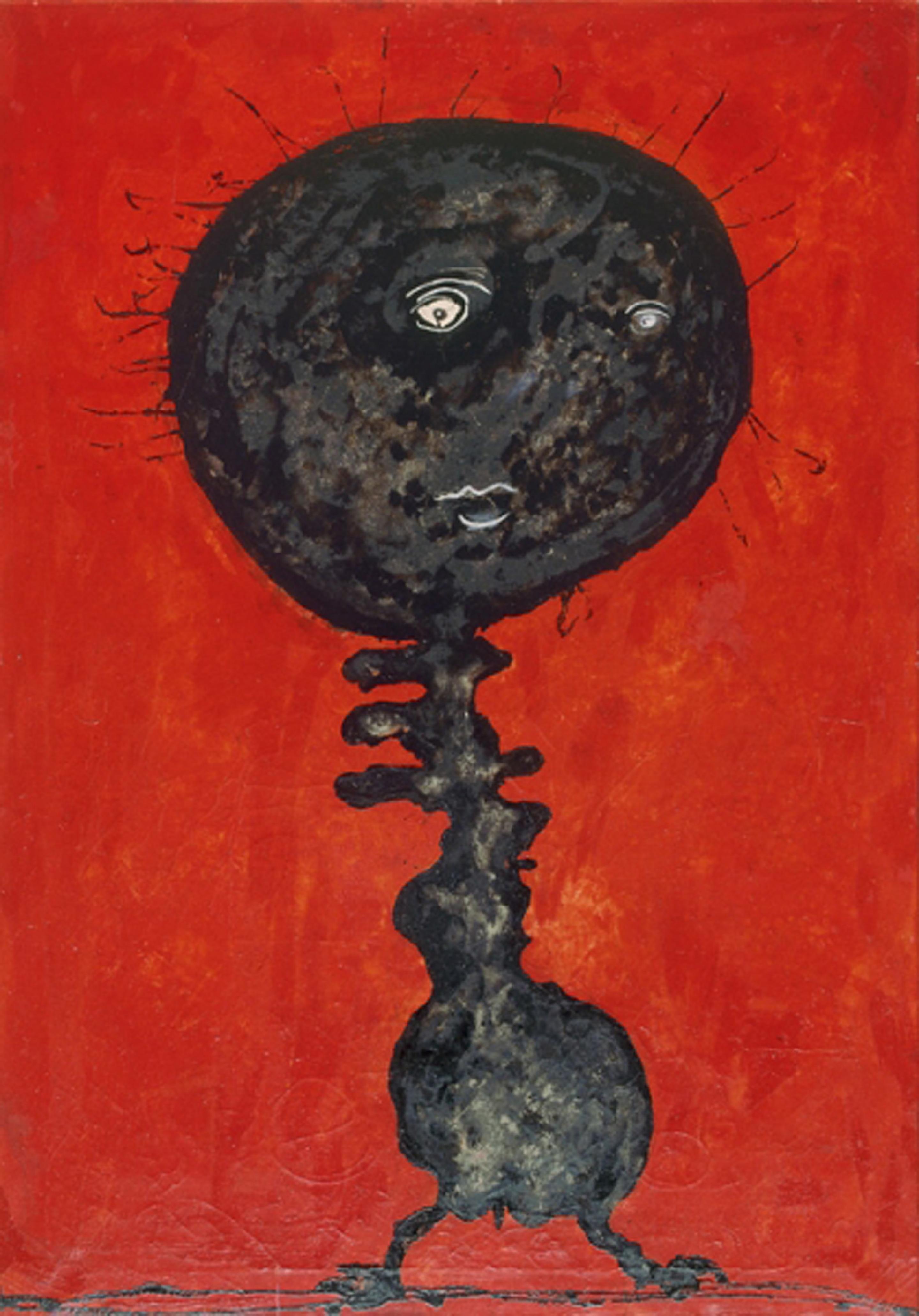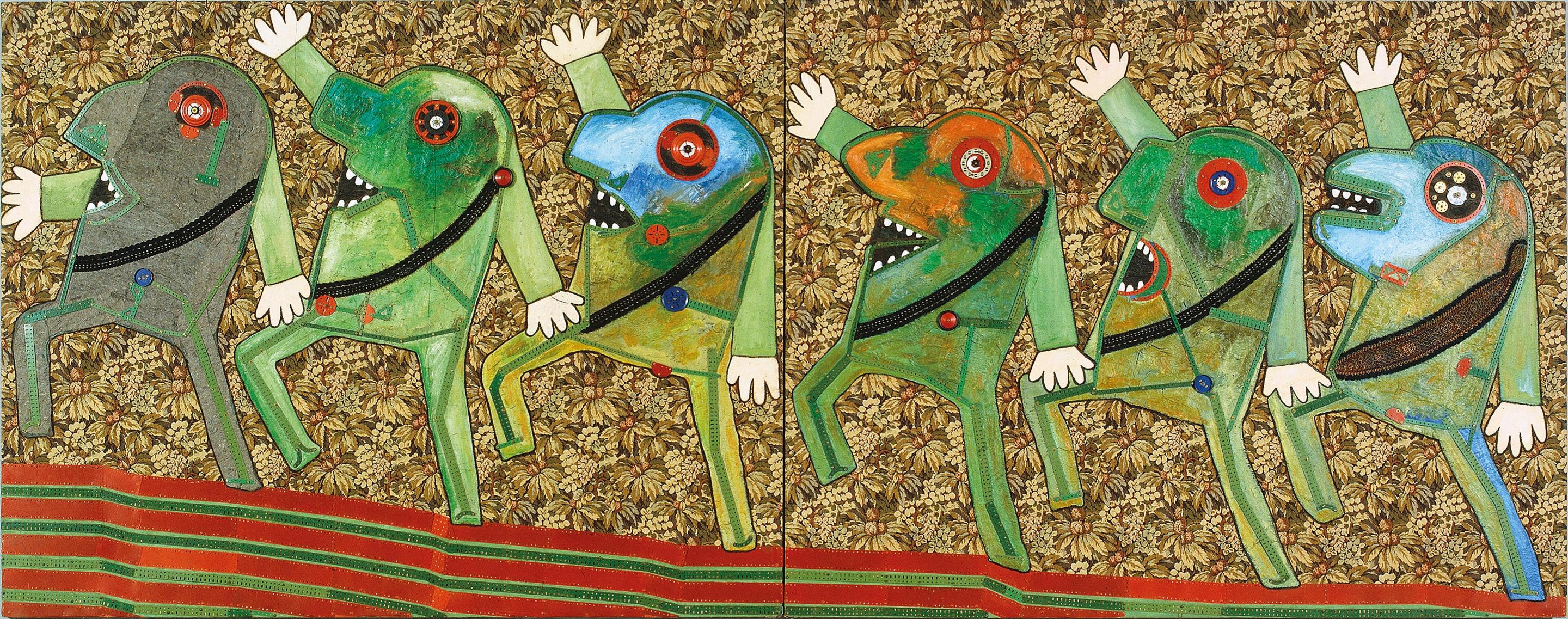EnricoBAJ
Enrico Baj. Art is freedom
11.2017–02.2018
Enrico Baj. Art is freedom
11.2017–02.2018
Press Release
Enrico Baj
Art is freedom
Opening: November 7, 2017
November 8, 2017 – February, 17 2018
Art is freedom
Opening: November 7, 2017
November 8, 2017 – February, 17 2018
To conclude its 2017 exhibition programme, the Marconi Foundation is pleased to present an exhibition dedicated to Enrico Baj, a prominent figure in the contemporary artistic perspective.
Heir to the surrealist-dadaist spirit and an experimenter in original techniques and styles, in 1951 he promoted the Nuclear Movement together with Sergio Dangelo.
In 1953 he met Asger Jorn, with whom he founded the International Movement for an Imaginist Bauhaus, opposing the forced rationalisation and geometrisation of art.
From the Fifties on, he was a figure on the international scene and exhibited regularly, especially in Paris.
His debut in the United States came with an exhibition in 1960.
In 1967 he began to work with Studio Marconi. André Breton in France invited him to exhibit with the surrealists and in 1963 wrote an essay about him, published in Rosamond and George Bernier’s magazine "L’oeil".
Brilliant at collage, which for him had literary origins, Baj applied it in the way of Alfred Jarry, who in his writing “introduced fragments of other texts, using them in contexts that differed from the one they had been written for.”
A distinguishing hallmark of Baj’s work are the Ladies and the Generals: imaginary characters he created in order to make a barely concealed political critique, later unmistakeably evident when he began to create his Rallies and Military Parades.
A frequent presence at Studio Marconi, Enrico Baj was one of the most represented and beloved artists of his friend and gallerist Giorgio Marconi.
This year’s exhibition of Baj’s work at the Fondazione Marconi, organised in collaboration with the Baj Archive in Vergiate, has a decisively political thrust and emphasises the Milanese artist’s social denouncement of any form of power and oppression.
The show’s itinerary follows a more thematic than chronological order. The first Meccano works from the Sixties are followed by a selection of the famous Generals and the Parade of 6 (1964), while the last room on the ground floor hosts the monumental work entitled Funeral of the Anarchist Pinelli (1972).
The twelve-metre-long installation was the result of three years’ work, inspired by the death of anarchist Giuseppe Pinelli, who fell from a window at the Milan Police Headquarters, where he was being held under suspicion of having taken part in the massacre at Piazza Fontana.
The widely-reported event, which took place in Milan on 15 December 1969, still reverberates in the nation’s memory and remains one of the many unresolved puzzles of that tormented period. “So, I was asked an image, and an image I have made, so that there will be a lasting testimony to the event, to him, to the violence he suffered, to Licia’s grief, and to Claudia and Silvia.” (Enrico Baj, 1972)
Heir to the surrealist-dadaist spirit and an experimenter in original techniques and styles, in 1951 he promoted the Nuclear Movement together with Sergio Dangelo.
In 1953 he met Asger Jorn, with whom he founded the International Movement for an Imaginist Bauhaus, opposing the forced rationalisation and geometrisation of art.
From the Fifties on, he was a figure on the international scene and exhibited regularly, especially in Paris.
His debut in the United States came with an exhibition in 1960.
In 1967 he began to work with Studio Marconi. André Breton in France invited him to exhibit with the surrealists and in 1963 wrote an essay about him, published in Rosamond and George Bernier’s magazine "L’oeil".
Brilliant at collage, which for him had literary origins, Baj applied it in the way of Alfred Jarry, who in his writing “introduced fragments of other texts, using them in contexts that differed from the one they had been written for.”
A distinguishing hallmark of Baj’s work are the Ladies and the Generals: imaginary characters he created in order to make a barely concealed political critique, later unmistakeably evident when he began to create his Rallies and Military Parades.
A frequent presence at Studio Marconi, Enrico Baj was one of the most represented and beloved artists of his friend and gallerist Giorgio Marconi.
This year’s exhibition of Baj’s work at the Fondazione Marconi, organised in collaboration with the Baj Archive in Vergiate, has a decisively political thrust and emphasises the Milanese artist’s social denouncement of any form of power and oppression.
The show’s itinerary follows a more thematic than chronological order. The first Meccano works from the Sixties are followed by a selection of the famous Generals and the Parade of 6 (1964), while the last room on the ground floor hosts the monumental work entitled Funeral of the Anarchist Pinelli (1972).
The twelve-metre-long installation was the result of three years’ work, inspired by the death of anarchist Giuseppe Pinelli, who fell from a window at the Milan Police Headquarters, where he was being held under suspicion of having taken part in the massacre at Piazza Fontana.
The widely-reported event, which took place in Milan on 15 December 1969, still reverberates in the nation’s memory and remains one of the many unresolved puzzles of that tormented period. “So, I was asked an image, and an image I have made, so that there will be a lasting testimony to the event, to him, to the violence he suffered, to Licia’s grief, and to Claudia and Silvia.” (Enrico Baj, 1972)
Speaking of the work in his Automitobiografia, Baj wrote “More than about his funeral, it was about the man himself, the anarchist who fell to the ground on a hypothetical pavement, in front of a not so hypothetical police headquarters. In the background of the work, a group of anarchists are on the left and a group of police on the right confront each other: the police are wielding coshes and rifles and suppressing the anarchists’ march…”
Partly inspired by Carrà’s Funeral of the Anarchist Galli, and partly by Picasso’s Guernica, from which Baj took certain figures, revisiting these real characters in a grotesque style, the installation was and still is an emblematic work of courageous civil condemnation at a time where artists were for the most part choosing less compromising themes.
The work was to have been exhibited in the Great Hall of Caryatids, Palazzo Reale, in May 1972, but on the very day of the inauguration, Police Commissioner Luigi Calabresi was assassinated and the exhibition was postponed.
Forty years passed before it was exhibited again in Milan, in the same venue.
Obviously, this is not merely a private drama. Baj is portraying a Milan, indeed an entire country, marked by disillusionment after the post-war reconstruction and by the acts of violence that were perpetrated in Italy in those years.
On the first floor, a number of canvases from the cycle Apocalypse create a continuity with Funeral of the Anarchist Pinelli that is not visual alone.
Conceived by Baj as a composite work, almost like a puzzle open to a variable structure, the cycle contains many references and cultural links to Picasso, Arp, Pollock, Seurat and others. Created after Baj’s experience with Nuclear painting, it takes its theme from Civilised Man’s Eight Deadly Sins by Konrad Lorenz and is the mirror of a world in decay, “the revelation of the ethical and aesthetic evil of our society” (Gillo Dorfles 2001).
The exhibition ends on the second floor with a selection of works from the Nuclear period (including Two Night-time Characters and Little Child with his Toys from 1952), a theme particularly dear to Baj from the outset, because “you cannot remain indifferent to the atomic bomb, perceived as a monstrosity and passed off as a future source of energy.”
From nuclear danger to that of militarism, from the abuse of power to the many evils of modern world, all the major fears of our time pass before us in the works on show, some of them sadly all too real at the present time.
Moreover, the word “baj”, as the artist liked to recall, means “balladeer” in Polish.
It is not by chance that the exhibition opens with Screaming Personage (1964), recently exhibited at the Cobra Museum in Amstelveen (Netherlands).
Baj’s entire oeuvre, in fact, narrates and demonstrates why ultimately, as he used to put it: “Painting is a road – a road I chose – to freedom. It’s the practice of freedom.”
As usual, the exhibition continues at Studio Marconi ’65 with a selection of graphic works.
Partly inspired by Carrà’s Funeral of the Anarchist Galli, and partly by Picasso’s Guernica, from which Baj took certain figures, revisiting these real characters in a grotesque style, the installation was and still is an emblematic work of courageous civil condemnation at a time where artists were for the most part choosing less compromising themes.
The work was to have been exhibited in the Great Hall of Caryatids, Palazzo Reale, in May 1972, but on the very day of the inauguration, Police Commissioner Luigi Calabresi was assassinated and the exhibition was postponed.
Forty years passed before it was exhibited again in Milan, in the same venue.
Obviously, this is not merely a private drama. Baj is portraying a Milan, indeed an entire country, marked by disillusionment after the post-war reconstruction and by the acts of violence that were perpetrated in Italy in those years.
On the first floor, a number of canvases from the cycle Apocalypse create a continuity with Funeral of the Anarchist Pinelli that is not visual alone.
Conceived by Baj as a composite work, almost like a puzzle open to a variable structure, the cycle contains many references and cultural links to Picasso, Arp, Pollock, Seurat and others. Created after Baj’s experience with Nuclear painting, it takes its theme from Civilised Man’s Eight Deadly Sins by Konrad Lorenz and is the mirror of a world in decay, “the revelation of the ethical and aesthetic evil of our society” (Gillo Dorfles 2001).
The exhibition ends on the second floor with a selection of works from the Nuclear period (including Two Night-time Characters and Little Child with his Toys from 1952), a theme particularly dear to Baj from the outset, because “you cannot remain indifferent to the atomic bomb, perceived as a monstrosity and passed off as a future source of energy.”
From nuclear danger to that of militarism, from the abuse of power to the many evils of modern world, all the major fears of our time pass before us in the works on show, some of them sadly all too real at the present time.
Moreover, the word “baj”, as the artist liked to recall, means “balladeer” in Polish.
It is not by chance that the exhibition opens with Screaming Personage (1964), recently exhibited at the Cobra Museum in Amstelveen (Netherlands).
Baj’s entire oeuvre, in fact, narrates and demonstrates why ultimately, as he used to put it: “Painting is a road – a road I chose – to freedom. It’s the practice of freedom.”
As usual, the exhibition continues at Studio Marconi ’65 with a selection of graphic works.





















